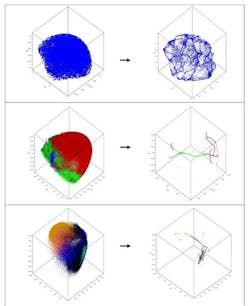Quantum Mechanics Researcher Uses Maple to Refine Cancer Treatment
Companies are faced with several challenges related to the inadequate resources necessary to process data. A long-time Maple user and quantum mechanics researcher, Marvin Weinstein, refers to the problem of extracting meaning from large data sets as, “How do we find a needle in a multi-dimensional haystack, when we don’t know what a needle is, and we don’t know if there is a needle in the haystack?”
Dynamic Quantum Clustering (DQC) accomplishes this feat by creating a density map of data using DQC’s proprietary Maple library, and Maple’s powerful visualization tools. The result of a DQC analysis is a Maple animation that provides a visual record of the complex computations going on behind the scene. According to Marvin, Maple animations have been a big part of DQC’s success because they reveal answers without the complex mathematics. He says that “these animations sell our product because they leverage the human ability to spot patterns developing in time and space.”
With Maple’s prototyping abilities and customizable features, Marvin was able to get DQC up and running within a week. Marvin confesses that “whenever I can avoid having to do things [manually], I do so.” By using the DQC compiled library within Maple, it was possible for Quantum Insights to have a powerful GUI without having to build the interface from scratch. Marvin believes that time is often wasted with unnecessary coding and analysis tasks, and exploits many of the built-in features of Maple to save time drive his research forward.
The core of DQC is an algorithm that maps a problem of unsupervised clustering to a problem in quantum mechanics. It uses quantum evolution to identify correlated information and reveals the details of the process through a Maple animation. This animation typically reveals hidden and unexpected insights into complex data. Marvin asserts that the aim of DQC is to “let the data speak for itself”. The advantage of working without making assumptions or hypotheses, without cleaning the data, and without the need for expert knowledge means that DQC is a data exploration method that is faster, cheaper and more efficient than current methods.
One of DQC’s major accomplishments thus far has been the identification of several biomarkers strongly correlated with multiple cancers. According to Marvin, TCGA analysis was selected as the initial step towards cancer research because cancer is a problem that everyone understands to be a big deal, and “we’ve all lost people we love to cancer.” The hope was that better clustering methods would allow mRNA from various tumour samples to better classify tumors into biologically relevant groups. The study identified 48 of 73,000 mRNA expressions that defined all five different cancer types. This analysis, published in Nature Scientific Reports, has demonstrated the ability to provide an accurate diagnosis of cancer type, based on molecular information alone, and has further revealed significant sub-typing of cancer cells, beyond what pathologists can currently achieve. The sensitivity to variation in mRNA expression patterns is the “holy grail” of precision medicine, because it promises to tell us which tumors are likely to respond to a drug and which tumors will not respond. Moreover, the analysis showed that DQC significantly outperformed tSNE-HDBScan, the current gold standard clustering method used in cancer data analytics.
Now, Marvin is working in pharmacogenomics to offer better diagnosis and treatment methods for cancer and other diseases. His company, Quantum Insights, is working towards developing effective, data-driven strategies. While Quantum Insight’s initial focus was cancer, the goal is to expand this research into other healthcare applications. Marvin believes that the DQC technique will help save lives wherever better analytics are required. Other successful applications of his research include Alzheimer’s data, detection of contraband nuclear material, analysis of the Sloan Digital Sky Survey Data, and other areas that utilize large amounts of data.

